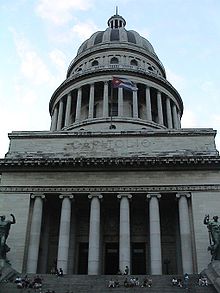Capitol (Havana)
The Capitol ( Spanish Capitolio ) of Havana in Cuba was built in 1929 as the seat of the legislature and served this purpose until 1959. After eight years of renovation, it was reopened to visitors in March 2018.
Building history
The Havana Capitol was originally planned as the seat of government in 1912. During the reign of the fifth President of the Republic of Cuba and dictator Gerardo Machado , the building was inaugurated on May 20, 1929, but Parliament did not move into it until two years later.
The area on which the Capitol is located was originally a marshland and was first used as a shelter for slaves during the Spanish colonial period and later as a botanical garden. The architects were the Cubans Raúl Otero and Eugenio Rayneri Piedra , under whose direction the building was built between 1926 and 1929.
architecture
In its outer shape, the building, built in the classicism style, is reminiscent of the US Capitol in Washington, DC , which is larger overall, but slightly lower at its highest point. In terms of shape and size, the Cuban architects were influenced in their design by the Panthéon in Paris and St. Peter's Basilica in Rome .
The allegorical woman statue in the entrance hall embodies the Republic of Cuba. It was designed by the Italian sculptor Angelo Zanelli . Lily Válty, a woman from Havana, served as his model. The gilded bronze statue is 17 m high and 40 tons in weight. A 24-carat diamond set in gold can be seen in the floor of the entrance hall, the “Star of Cuba”. It marks kilometer zero on the Cuban road network.
The conference rooms bear the names of places and personalities who played an important role in the history of the liberation struggle against Spanish colonial rule (1868–1898): Baire, Baraguá , Yara and Jimaguayú as well as José Martí and Simón Bolívar . The mighty bronze entrance gates are adorned with reliefs depicting the entire history of Cuba from the 1492 conquest by Christopher Columbus to the time the Capitol was built. After the overthrow of the dictator Gerardo Machado in 1933 by a popular movement, all references to him were made unrecognizable by the angry population.
Current usage
An extensive renovation of the building began in 2010. The responsible authority commissioned a German company to restore the facade. In 2013, the Cuban President Raúl Castro announced that the " National Assembly of People's Power ", which meets twice a year, would use the building as its seat in the future. In November 2016, the President of the National Assembly, Esteban Lazo , inaugurated the Capitol in his new role when he received the Vietnamese President Trần Đại Quang there . Since March 2018, visitors have again been granted access to the building, the last renovation work of which should be completed by the celebrations for the 500th anniversary of the city's foundation in November 2019.
gallery
Web links
- On the urban location in Havana (PDF file; 5.0 MB)
- Abierto al público el Capitolio Nacional (+ photos) Article from the Cuban state news agency with current photos of the renovated building, March 1, 2018 (Spanish)
Individual evidence
- ↑ a b El Capitolio de La Habana reabre tras ocho años de restauración. In: Diario Las Américas of March 1, 2018, accessed on March 15, 2018 (Spanish)
- ↑ a b La restauración del Capitolio de La Habana. In: El Nuevo Herald of October 18, 2015, accessed March 15, 2018 (Spanish)
- ↑ Eichsfelder is restoring the facade of the Capitol in Havana. In: Thüringer Allgemeine from April 18, 2015, accessed on March 15, 2018
- ↑ Cuba's capitol: Ink wells v internet points. In: BBC News of September 13, 2013, accessed March 15, 2018
- ↑ Con la presencia de Tran Dai Quang Quedo inaugurada la nueva sede de la Asamblea Nacional. In: Granma, November 17, 2016, accessed March 15, 2018 (Spanish)
- ↑ Cuba's Capitol reopens after years of restoration. In: Swissinfo from March 1, 2018, accessed on March 15, 2018 (English)
Coordinates: 23 ° 8 '7 " N , 82 ° 21' 34" W.






